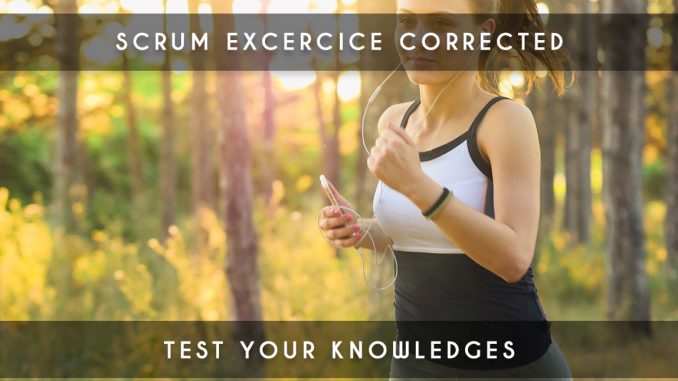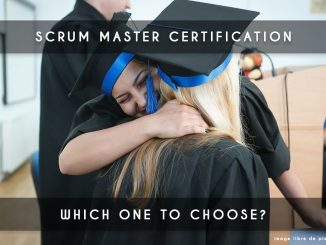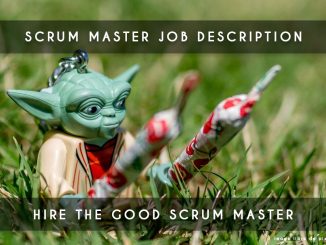
Mastering Scrum: Corrected Exercise
Are you ready to put your Scrum knowledge to the test? Let’s work through a corrected exercise together to gauge your understanding of the intricacies of Scrum [Scrum Exercise Corrected].
Indeed, comprehending Scrum fully can be challenging. Some individuals struggle to grasp the roles and their real distribution within the framework. Now is the ideal moment to delve into the nuances of this agile methodology.
Corrected Scrum Exercise
In this corrected exercise, I’ll provide you with the questions and answer choices. Feel free to jot down your responses on paper and review the answers after completing all the questions.
Don’t be discouraged—the questions might not be straightforward, and some challenge widely held beliefs.
Multiple correct answers are possible for certain questions! The reference for answering these questions is the Scrum Guide. Try to tackle this exercise without having the guide open in front of you.
1/ Question 1
In Scrum, who validates the user stories to transition them from “test” to “done”?
[ ] the Scrum Master
[ ] the Product Owner
[X] the Development Team
[ ] the entire team
While the notion that the Product Owner verifies user stories might be widespread due to its logical appeal, it’s actually the Development Team’s responsibility to ensure potentially deliverable “done” user stories.
2/ Question 2
The Development Team may include:
[X] front-end and back-end developers
[X] developers, a business analyst, and a tester
[X] a tester and developers
[X] developers, a PMO, and a tester
All answer choices are correct. The term “Development Team” encompasses not just developer roles, but everyone involved in product realization. Thus, Business Analysts, PMOs, Testers, and others can be part of the Development Team.
Another valid answer could be: “No checkboxes selected.” The Development Team isn’t bound by specific titles, so the accurate answers would be:
[X] individuals with front-end and back-end development skills
[X] individuals with development, business analysis, and testing skills
[X] individuals with developer and testing skills
[X] individuals with development, PMO, and testing skills
Indeed, it’s nuanced.
3/ Question 3
Product Backlog refinement is:
[X] the updated term for backlog grooming
[ ] a Scrum ceremony
[X] a practice involving refining user stories and estimating through poker planning
[ ] not officially recognized in Scrum
Only the first answer is true. The term “grooming” carried inappropriate connotations, leading to its replacement by “Product Backlog refinement.”
Article: Backlog Grooming
Product Backlog refinement isn’t a ceremony, though it’s often performed in a ceremonious manner. The Scrum Team decides how to refine items; it need not necessarily follow formal ceremonies.
Remember that the Scrum Guide refers to “items” instead of “user stories.” While user stories are popular, Scrum’s term is “items.” Teams define what constitutes an “item,” which isn’t necessarily limited to user stories. Additionally, estimating through poker planning isn’t native to Scrum.
4/ Question 4
What artifacts exist in Scrum?
[X] the Definition of Done
[ ] the Definition of Ready
[X] Sprint Backlog
[ ] Backlog Increment
The Definition of Ready is a prevalent practice but isn’t recognized by the Scrum Guide. This absence might have specific reasons, but it can sometimes lead to making Scrum less agile.
Article: Definition of Ready (DOR)
Backlog Increment isn’t an artifact; don’t confuse it with the “Increment” artifact. The Increment comprises “done” elements from the current sprint and those completed in prior sprints. This artifact doesn’t involve a backlog concept.
5/ Question 5
The Product Owner is responsible for:
[ ] confirming that items are indeed “done”
[X] Product Backlog management
[X] ensuring the Development Team understands the items
[ ] making the Sprint Backlog transparent
The Product Owner manages and ensures understanding of the Product Backlog. However, the Product Owner isn’t responsible for the Sprint Backlog; that’s solely the Development Team’s responsibility.
Article: Sprint Backlog
The Product Owner isn’t accountable for development work. Only the Development Team must establish quality standards and validate




1 Trackback / Pingback